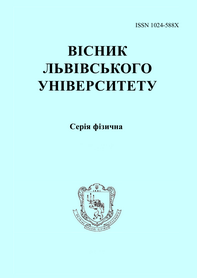Visnyk of the Lviv University. Series Physics
60 (2023) ñ. 78-89
DOI: https://doi.org/10.30970/vph.60.2023.78
Isotropicity in rubidium sulphate crystals
I. Pryshko, V. Stadnyk, P. Shchepanskyi, L. Karpliuk, N. Ftomyn
|  |
The work is devoted to the study of optical isotropic points in Rb2SO4 crystal. The isotropic points here imply an increasing in the symmetry of the optical indicatrix when the spectral range or temperature changes. The very transition through isotropic point is accompanied by a change in the sign of birefringence of the crystal, that is, its inversion takes place. The crystals for study were obtained by the method of slow evaporation of water from repeatedly recrystallized solution of pure rubidium sulfate Rb2SO4 salt. The crystal structure of obtained samples was studied by means of X-ray powder diffraction spectra. Measurement of refractive indices ni(T) and birefringence \Delta ni(T) of the crystal were carried out in the range from room temperature to liquid nitrogen temperature of 77 K for three polarizations of light E \mid\mid X, E \mid\mid Y and E \mid\mid Z. It was found that the dependences of ni(T) increase almost linearly with decreasing temperature, and |dnz/dT|>|dnx/dT|\geq|dny/dT|. For a light wavelength of \lambda=500 nm, the intersection of nz(Ò) and ny(Ò) curves at room temperature, and the intersection of nz(Ò) and nõ(Ò) curves at a temperature of 85 K were found, which approve the existence of isotropic points in this crystal. It is established that the dispersion of \Delta ni(\lambda) is normal d(\Delta n³)/d\lambda<0, and d(\Delta nõ)/d\lambda>d(\Delta nz)/d\lambda>d(\Delta ny)/d\lambda. The temperature transformations of the optical indicatrix of the rubidium sulfate crystal in the case of a temperature decreasing, namely transitions from an optically biaxial to an optically uniaxial state, are analyzed. Since the second isotropic point in Rb2SO4 exists in the region of low temperatures, this crystal can be used as a working element of a crystal-optical temperature sensor in the temperature range of 75-90 K. The influence of uniaxial pressure on the birefringent properties of the crystal, as studied using a special attachment to a nitrogen cryostat, are also analyzed in this work. The effect of uniaxial compression \sigmam on changes of \Delta ny (T, \lambda) is established and their significant sensitivity is revealed. Herewith, \sigmam do not change the character of these curves, but only change the absolute value of \Delta ni.
Full text (pdf)
References
- M. A. Hobben, Acta Cryst. A24, 676--680 (1968). doi: 10.1107/S0567739468001440.
- C. Schwartz, D. S. Chemla, B. Ayrault, R. C. Smith, Optics Communications. 5, 244--247 (1972). doi: 10.1016/0030-4018(72)90089-2.
- G. C. Bhar, Applied Physics. 13, 455 (1980). doi: 10.1088/0022-3727/13/3/018.
- S. C. Abrahams, J.L. Bernstein, Chem. Phys. 52, 5607--5613 (1970). doi: 10.1063/1.1672831.
- S. C. Abrahams, J.L. Bernstein, Chem. Phys. 59, 1625--1629 (1973). doi: 10.1063/1.1680242.
- Ì. Î. Romaniuk, Lviv, Ivan Franko LNU, 456 (2017).
- M. O. Romanyuk, A. S. Krochuk, I. P. Pashuk, Lviv, Ivan Franko LNU, 564 (2012).
- V. M. Gaba, Lviv, Liga-Press, 226 (2006).
- L. M. Suslykov, V. Yu. Slyvka, M. P. Fox, Kyiv, Interpress LTD, 294 (1998).
- O. S. Kushnir, P. A. Shchepanskyi, V. Yo. Stadnyk, A. O. Fedorchuk. Optical Materials 95, 109221 (2019). doi: 10.1016/j.optmat.2019.109221.
- V. Yo. Stadnyk, R. S. Brezvin, M. Ya. Rudysh, P. A. Shchepanskyi. Optics and Spectroscopy 117, 756--758 (2014). doi: 10.1134/S0030400X14110216.
- V. Yo. Stadnyk, M. O. Romanyuk, R. S. Brezvin. Ferroelectrics 192, 203--207 (1997). doi: 10.1080/00150199708216190.
- P. E. Tomaszewski, Phase Transit. 38, 127–220 (1992). doi: 10.1080/01411599208222899.
- O. Muller, R. Roy, Acta Cryst. 31, 2944 (1975). doi: 10.1063/1.3069161.
- L. Vinchel, G. Vinchel, Chicago, McCrone Research Institute, 410 (1989).
- M. Ya Rudysh, I. A. Pryshko, P. A. Shchepanskyi, V. Yo Stadnyk, R. S. Brezvin, Z. O. Kogut, Optik 269, 169875 (2022). doi: 10.1016/j.ijleo.2022.169875.
- V. M. Gaba, Acta Phys. Ðîl. 117, 129--132 (2010). doi: 10.12693/APhysPolA.117.129.
- M. O. Romanyuk, Lviv, Ivan Franko LNU, 362 (2012).
- B. Andriyevsky, W. Ciepluch-Trojanek, V. Stadnyk, M. Tuzyak, M. Romanyuk, V. Kurlyak, Journal of Physics and Chemistry of Solids. 68, 1892--1896 (2007). doi: 10.1016/j.jpcs.2007.05.017.
- V. Yo. Stadnyk, V. M. Gaba, B. V. Andrievskii, Z. O. Kogut, Physics of the Solid State 53, 131--137 (2011). doi: 10.1134/S106378341101029X.
- P. A. Shchepanskyi, O. S. Kushnir, V. Yo. Stadnyk, A. O. Fedorchuk, M. Ya. Rudysh, R. S. Brezvin, P. Yu. Demchenko, A. S. Krymus, Ukr. J. Phys. Opt. 18, 187--197 (2017). doi: 10.3116/16091833/18/4/187/2017.
- V. Y. Stadnyk, N. A. Romanyuk, R. S. Brezvin, Lviv, Ivan Franko LNU, 305 (2013).
- H. Horinaka, K. Tomii, H. Sonomura, T. Miyauchi, Jpn. J. Appl. Phys. 24, 755--760 (1985). doi: 10.1143/jjap.24.755.
- H. Horinaka, N. Yamamoto, H. Hamaguchi, Appl. Spectrosc. 46, 379--381 (1992). doi: 10.1366/0003702924125681.
- M. Susaki, N. Yamomoto, H. Horinaka, Jpn. J. Appl. Phys. 33, 1561--1564 (1994). doi: 10.1143/JJAP.33.1561.
- H. Horinaka, H. Sonomura, T. Miyauchi, Jpn. J. Appl. Phys. 24, 463--466 (1985). doi: 10.1143/JJAP.24.463.
- T. Yamomoto, H. Takehara, H. Horinaka, T. Miyauchi, Jpn. J. Appl. Phys. 25, 1397--1399 (1985). doi: 10.1143/JJAP.25.1397.
- H. Horinaka, T. Okudo, N. Yamomoto, Jpn. J. Appl. Phys. 28, 1328 (1989). doi: 10.1143/JJAP.28.1328.
- N. Syrbu, A. Dorogan, V. Ursaki, I. Stamov, I.M. Tiginyanu, Optics Communications 284, 3552--355 (2011). doi: 10.1016/j.optcom.2011.03.053.

